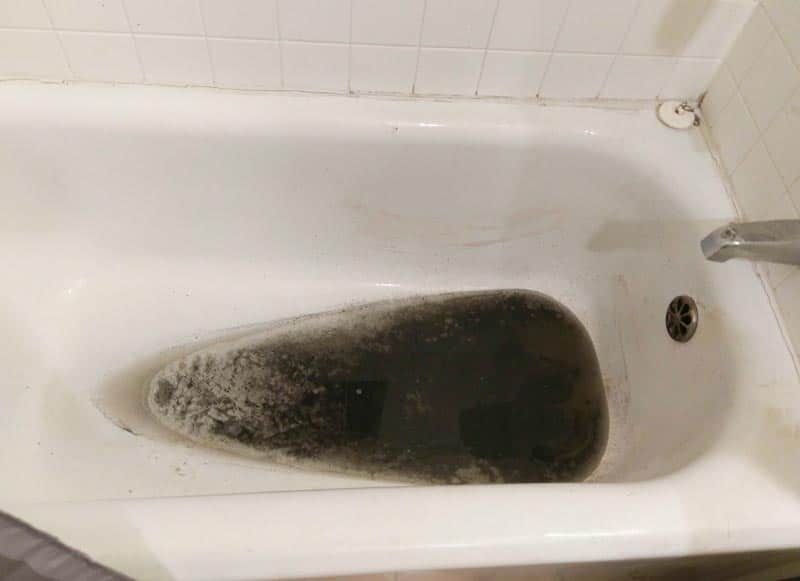What're your ideas regarding Why sewage is coming up through your bathtub?

Sewage backup in the tub can be a distressing and unhygienic trouble for any kind of homeowner. Not only is it inconvenient, yet it additionally positions severe health risks and suggests underlying problems with the plumbing system. Comprehending why sewage is showing up with the tub is crucial for taking appropriate action to deal with the problem efficiently.
Intro to the Issue
Comprehending the Trouble
When sewer draws back up into the tub, it's a clear sign of a problem with the water drainage system. The wastewater that needs to be flowing far from your home is rather locating its back into your home, which can cause substantial damage and health hazards.
Potential Reasons
Numerous factors can add to sewer back-up in the bath tub. From blockages in the sewer line to concerns with the plumbing facilities, determining the root cause is necessary for discovering a remedy.
Typical Reasons for Sewage Back-up
Blockages in the Drain Line
Among the most common causes of sewage backup is an obstruction in the sewage system line. This can happen as a result of the accumulation of debris, grease, or international things in the pipelines, stopping appropriate circulation and creating sewage to back up right into your bathtub.
Tree Origin Breach
Tree origins looking for dampness and nutrients can penetrate sewer lines via small fractures or joints. Gradually, these origins can grow and expand, creating considerable damage to the pipelines and causing sewage backup issues.
Aging Infrastructure
Older homes might have dated plumbing systems that are a lot more susceptible to corrosion, splits, and wear and tear. As pipelines age, they end up being more susceptible to leakages and obstructions, increasing the possibility of sewer backup events.
Heavy Rainfall or Flooding
During periods of heavy rainfall or flooding, the sewer system may become overloaded with excess water, creating back-ups and overflows. This can lead to sewage supporting into bathtubs and other fixtures inside the home.
Health And Wellness Dangers Associated with Sewer Back-up
Contamination of Water Supply
Sewer backup can contaminate the supply of water in your home, posing a serious wellness danger to you and your household. Direct exposure to polluted water can lead to intestinal issues, skin infections, and various other diseases.
Spread of Disease
Sewer includes harmful bacteria, infections, and bloodsuckers that can cause a range of conditions, consisting of liver disease, cholera, and gastroenteritis. Entering into contact with sewer or infected surface areas puts you in danger of infection.
Mold Development
Dampness from sewage backup can develop ideal problems for mold and mildew development in your house. Mold and mildew spores can intensify respiratory problems and cause allergies in sensitive people, making timely cleanup vital.
Indications of Sewer Backup
Foul Odors
Unpleasant odors emanating from drains or components, particularly in the bathroom, may suggest sewer backup problems. These smells are often strong and consistent, indicating a problem that calls for prompt attention.
Slow Draining Fixtures
Bathtubs, sinks, and toilets that drain pipes slowly or otherwise at all could be experiencing sewer back-up. If several components are influenced at the same time, it's likely that the concern originates from a common point, such as the main sewage system line.
Gurgling Noises
Strange gurgling or gurgling noises coming from drains when water is running elsewhere in the house are indicative of air caught in the plumbing system. This air build-up can result from sewage backup and need to be investigated promptly.
Immediate Actions to Take
Shutting Off Supply Of Water
In case of sewage back-up, it's necessary to switch off the water system to stop further contamination and damages. Situate the main water shutoff valve in your house and shut it off up until the problem can be dealt with.
Calling a Specialist Plumber
Taking care of sewage back-up is not a do it yourself task. Get in touch with a qualified plumber with experience in taking care of sewage-related concerns to analyze the scenario and carry out necessary repair work or cleanings.
Preventing Contact with Contaminated Water
Up until the sewer backup is resolved, prevent contact with infected water to prevent the spread of germs and virus. Wear protective gear if you need to be in the damaged location and wash your hands thoroughly afterward.
Safety nets
Regular Upkeep of Sewage System Lines
Schedule regular evaluations and maintenance of your sewer lines to identify and deal with prospective issues prior to they intensify right into significant problems. This can include clearing out particles, evaluating for tree root breach, and repairing any kind of damaged pipelines.
Mounting Backwater Valves
Consider installing bayou valves in your plumbing system to stop sewage from receding into your home throughout periods of heavy rainfall or flooding. These valves instantly close when water starts backing up, securing your property from contamination.
Correct Disposal of Household Waste
Avoid flushing anything aside from toilet paper and human waste down the commode to stop clogs and obstructions in the sewer line. Dispose of grease, oil, and various other home chemicals appropriately to minimize the danger of plumbing issues.
Cleaning Up After Sewer Backup
Sanitation Procedures
Extensively disinfect and sanitize impacted locations after sewage back-up to eliminate damaging microorganisms and protect against mold growth. Usage proper cleansing products and protective equipment to guarantee risk-free and effective clean-up.
Repair of Affected Areas
Repair any type of damages to floor covering, walls, or fixtures triggered by sewage backup. Relying on the level of the damage, you might need to replace carpets, drywall, or other products to recover your home to its pre-loss problem.
Why Is Water Backing Up in My Bathtub When I Flush My Toilet?
What to do about a sewer line clog
First, don’t bother with plunging. No amount of plunging will dislodge the clog in a sewer line. The clog is too far away. Plungers are for clogs in the toilet itself, not the sewer line. Plus, the most likely causes of a sewer clog are:
Tree roots Flushed toys or feminine products Grease buildup Those items don’t move easily. And in the case of tree roots, the roots need to be cut out of the pipe and the pipe will need to be repaired.
You’ll need a closet auger. A closet auger is a type of plumber’s snake with a protective cover to keep from scratching the delicate porcelain toilet. If the clog is further down, you may need to remove the toilet or use one of your cleanouts to get to the clog.
We also recommend doing a video inspection of the drain to ensure that the cause of the clog has been completely removed. Otherwise, you could have the same problem again in a few days or weeks.
https://mspplumbingheatingair.com/blog/why-is-water-backing-up-in-my-bathtub-when-i-flush-my-toilet

Hopefully you liked our topic about . Thank you for taking time to read through our content. Enjoyed reading our content? Please quickly share it. Help another person find it. Kudos for your time. Kindly visit our site back soon.
Book Instantly